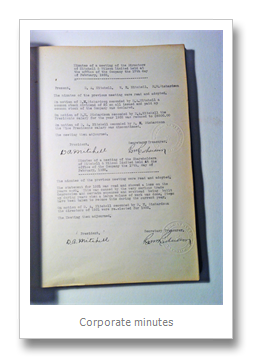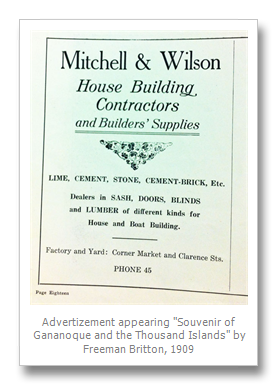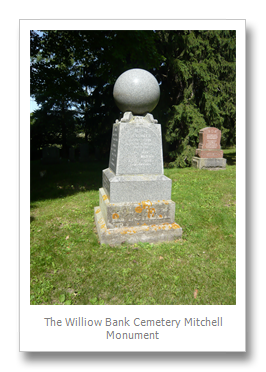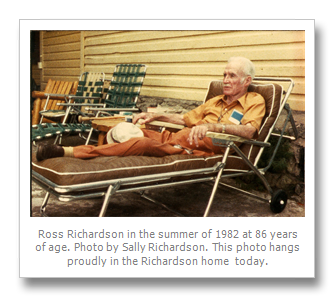The 3-ring, leather, binder is the best “read” I have had in many years. Neither a novel or a piece of non-fiction it is the company-minute book of contractors Mitchell & Wilson.
“Would you be interested in seeing the company Minute Book?” Ewart asked. “I certainly would,” I said and since then I have read the book, made several pages of notes, and created an Ancestry.Com Mitchell family tree to keep track of the “kin-folk”.
Once into the book, I realized that Ewart was not only generous with the information, but was following in the footsteps of his father, his uncles, his grandfather and his great grandfather – all true examples of gentlemen who celebrated their family history. It was Ross Richardson, Ewart’s father who captured much of the original family history on paper. His seven page review describe five generations of family history. Then his uncle by marriage, Fred R. Laughton, compiled “Mitchell & Wilson, Limited in Retrospect, Miscellany Personalities” describing the material not as a chronological record, “ for such records do not exist”, but “rather, these scraps of history, little anecdotes and general background are almost entirely word-of-mouth stories passed down through the years to Ross Richardson, Albert Harper and Fred Laughton…”

Why is this minute book important? M & W built the Gananoque Clock Tower, the Electric Light Company and some of the largest island homes including Limberlost (foot of Hill Island), Nokomis Lodge (Howe Island), Benson’s Island (Ivy Lea). They also built schools, churches, and factories.
In 1833, George Mitchell, 24, arrived in Canada. He came to Gananoque and built a small house (now on the property of the 401 overpass). He tried farming but disliked it. One day he decided to go west, and walked the 18 miles to Kingston. When he got to the town of Barriefield he climbed the hill which overlooked the mouth of the Cataraqui River and Kingston’s harbour. On the horizon were retreating puffs of smoke from the passenger steamer indicating that his trip, to parts unknown, was not going to occur that day – he missed the boat.
As it would be a week until the next steamer, he headed back to Gananoque. He found employment for a year and then moved to Cobourg, Ontario, where he spent five years learning to be a wagon-maker. He then moved to Kingston, working as a guard at the Kingston Penitentiary. Finally, in 1842, he established his first Gananoque business as a carriage shop, later adding “joiner work” and “house building”.
George Mitchell was 31 when he proposed and married 16 year old Jane Brown. The Mitchell family has a handwritten letter which George sent to Jane shortly before their wedding explaining. “I will just mention a few things that I wish you to consent to before that we are joined to each other which if duly considered may prove beneficial both to our own good as Christians and also promote the glory of God. “ There were ten points and they appear as an appendix to this article.
In 1854 George Mitchell paid about 334₤ to W.S. Macdonald, for a property on the Gananoque river near the upper dam. The next year it burned down and was replace by a three-story-stone building. The “Mitchell Carriage Factory” occupied the top two floors. Mitchell had a partner William Gorham, who ran the carriage factory while George did the joinery work and built houses. Many standing today.
George and Jane (1824-1908) had four sons and five daughters. George loved music and, as there was no organ at St. Andrew’s United Church, it was he who struck the tuning fork to lead the singing of psalms and hymns! In honour of their parents, the family installed a stained-glass window in the church with the inscription “To the Glory of God and in Loving Memory of Geo. Mitchell and Jane Brown who worshipped in this church from its organization for upwards of 40 years.”

The minute book contains the family genealogy with each marriage, death, and other pertinent information, recorded. John, the eldest son died tragically in 1867 at 21 on the M&W shop floor. “John went in to Mr. Hall’s turning shop, in the building, to grind some knives on the grindstone. He bent over to dip water from a hole in the floor which was kept open to allow sawdust to fall from a large circular saw into the water below. As he stooped down under the saw, his head came in contact with the saw and a ¼ “ cut was made in his skull. He died eight days later.”
James the third son is distinguished as being among the first 300 members of the North West Mounted Police when it was formed in 1872. He belonged to the Gananoque Militia as a drummer and bugler. He first served, at the age of 14, in the defense of Prescott, Ontario against the Fenians in 1866, and 1870.
James returned to Gananoque and married Helen Johanna Brough in April 1875 returning to the west in 1877 to settle in Winnipeg, Manitoba. It was there that George senior and his wife moved, later to return to Gananoque, in poor health, in the 1880s. He is buried in the Willowbank cemetery. When he returned he brought his third son, David. It was David, along with his mother Jane, who signed an agreement that linked the Mitchells with Mr. David Wilson and the partnership of Mitchell & Wilson began on May 17, 1892.
It was agreed that both David Mitchell and David Wilson would pay Mrs. George Mitchell (Jane) $3,000 for the business. It is surmised that the agreement was a way to “obtain cash to settle Mr. Mitchell’s estate and apparently since David Wilson was one of a few who had money available at that time, he was taken onto the business as a partner.”
Wilson was a bricklayer and looked after the construction division of Mitchell & Wilson while David Mitchell looked after the planing mill and supply business. In 1911, Wilson died of blood poisoning which set in after he cut his hand. The Minute Book reads, “During that period many of the beautiful homes on the St. Lawrence were built; also the Clock Tower, St. John’s School (the public high school) and the Nursing Home (then Skinner resident which cost at the time $6,500. ([in pen] Now the Sleepy Hollow B&B).”
Throughout the history of the Town of Gananoque the Mitchell family is intertwined with many families and industries. George and Jane’s daughter Jennett married W.G. Matthew in 1865. Matthew was one of the original partners of the Gananoque Spring and Axle Company which later became Ontario Steel Products and then Rockwell-International.
In 1912, David Mitchell sold the M&W building and property at the upper dam to the Jones Shovel Company. The building was demolished and an extension was built in its place as part of the Shovel enterprise.
M&W was expanding and more space was found on the north-west corner of Market and St. Lawrence Streets. There he built the original factory, office, three storage sheds and a stable for the horse. David Mitchell managed the business from 1886 to 1922.
David sister Ida married Matthew Richardson in Winnipeg, MN and they had four children. Ewart Mitchell Richardson was a dispatch rider in the First World War and was killed in action. He was too young to enlist, but lied about his age and joined at 16. Ida and her son Ross Richardson moved back to Gananoque in 1910. It was Ross who joined the business in 1922 taking the helm for the next 42 years. His uncle David died in 1937 at 77. David’s wife, held the office of Vice President of the company until she died in 1962. Their daughter Mary, became president in 1937.


Ross Richardson married Gretchen Reinhardt in 1931. Ross stepped down as manager of M&W in 1964. The Minute Book notes that “A retirement dinner was held at the Gananoque Inn on Tuesday, November 10 1964, honoring Ross. Approximately fifty guests were present including Joe Beaubien and Chas. Brown – two carpenters who had worked for Ross during many of his 54 years with the company. Mr. Brown had started with the firm in 1906. Also on hand were several employees, and contractors, associated with Mitchell and Wilson …….. ”
Ewart Richardson, Ross’ son, was appointed President, in 1976, succeeding Mary Elanor Laughton. Fred Laughton, her husband, was a Vice-President who retired in 1980. A special note was made of his many years of devoted service to the firm. The Fred Laughton Prize in Music was established at Gananoque Secondary School.
On July 1 1984 the community lost Ross Richardson and the minute book stated, “Mr. Richardson’s connection with the firm spanned a period in excess of 70 years and his knowledge and presence are sure to be missed.”
As this was the official corporate minute book it contains the record of each annual meeting of shareholders as well as the board of directors meetings, from 1924 to 1991. Perhaps the most interesting are the depression years.
1929: “The statement for 1929 showing a substantial increase in business and satisfactory earnings were read and adopted”.
1930 “…in view of the depressed conditions of business the earnings which are below 1929 we considered satisfactory.
1931 saw “ a loss on the years work. This was caused by the very serious trade depression and certain expenses and overhead being built up during years when a large volume of work was done. Steps have been taken to reduce this during the current year.”
1932 likewise, “general conditions throughout the country very little work was being done and this reflected in company’s business. Overhead has been cut down considerably and by passing the dividend the company can be kept in sound financial condition.
However, in 1935 there was “showed a slight expansion of business. And then 1936, “showed an encouraging increase in business…” The corner was turned.
Many towns have businesses that impact on their communities. Gananoque, known in the early days as the “Birmingham of Canada” has a proud history of manufacturers and enterprises. Certainly Mitchell & Wilson, House Building, Contractors and Builders’ Supplies is one that will be long remembered.
Part II – Mitchell & Wilson Ltd.’s Minute Book: “People and Places” will follow in August.